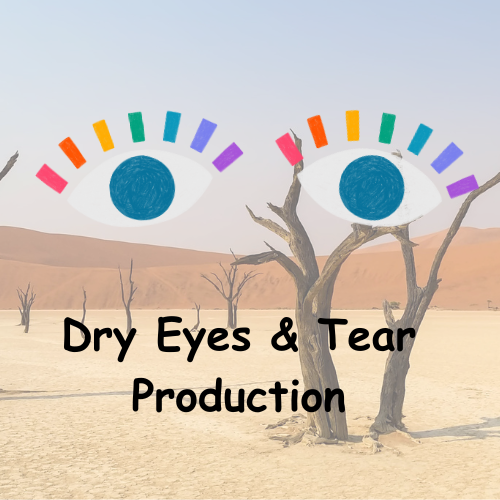Dry Eyes and Tear Production


Tear production is a cause of dry eye.
Tears are essential for maintaining the health of the eye and for clear vision. They contain a variety of proteins, enzymes, and other substances that help protect the eye from infection and inflammation.
When tears are not produced in sufficient amounts or have an imbalance in their composition, it can lead to dry eyes and other eye-related problems.
History of dry eyes as a medical condition
The first description of the condition is attributed to a Greek physician named Galen who lived in the second century AD. Galen observed that some people experienced discomfort and irritation in their eyes due to a lack of tears. He described this condition as “xerophthalmia,” which means “dry eyes” in Greek.
In the modern era, dry eyes were first classified as a medical condition in the 1940s. At that time, ophthalmologists recognized that many people who had eye discomfort, burning, and redness did not have any apparent underlying disease, infection, or injury. These patients were said to have “keratoconjunctivitis sicca,” which literally means “dryness of the cornea and conjunctiva.”
Since then, our understanding of dry eyes has improved significantly, and the condition is now recognized as a multifactorial disease with various causes and contributing factors. Today, there are many effective treatments available for dry eyes, ranging from simple lifestyle modifications to advanced medical and surgical interventions.
Tear production
Tears are produced in the lacrimal glands, which are located in the upper, outer corner of each eye socket. There are two types of lacrimal glands: the main lacrimal gland and the accessory lacrimal glands.
The main lacrimal gland is the larger of the two and is responsible for producing most of the tears. It is located under the brow bone above the outer corner of each eye. When you blink, the tears produced by the main lacrimal gland are spread across the surface of the eye to keep it moist and lubricated.
The accessory lacrimal glands are smaller glands located in the conjunctiva, which is the clear membrane that covers the white part of the eye and lines the inside of the eyelids. These glands produce a smaller amount of tears.
What are the meibomian glands?
The meibomian glands are small glands located in the eyelids, specifically in the tarsal plate, which is a dense connective tissue that provides structure to the eyelids.
The meibomian glands produce an oil called meibum, which is an essential component of the tear film that covers the eye’s surface. The oil helps prevent evaporation of tears and keeps the tear film stable, which is essential for maintaining clear vision and preventing dry eye symptoms.
There are approximately 20 to 30 meibomian glands in the upper eyelid and 20 in the lower eyelid. These glands are named after the German physician Heinrich Meibom, who first described them in the 17th century.
Meibomian gland dysfunction
Meibomian gland dysfunction (MGD) is a common condition that occurs when the glands become blocked, inflamed, or damaged, leading to a reduced or altered production of meibum. MGD is a major cause of dry eye disease and can cause symptoms such as eye irritation, redness, and blurred vision. Treatment of MGD typically involves a combination of warm compresses, lid massage, and other therapies aimed at improving the function of the glands.
Treatments available for dry eyes:
Eye Drops: Artificial tears are often the first line of treatment for dry eyes. The latest formulations of eye drops contain advanced lubricants and electrolytes to help restore moisture to the eyes and promote healing of the ocular surface. Some of these eye drops are preservative-free and can be used more frequently without causing irritation.
Punctal Plugs: These tiny plugs are inserted into the tear ducts to block them and prevent tears from draining too quickly. Punctal plugs help to keep the eyes moist and reduce dry eye symptoms.
Intense Pulsed Light Therapy: This is a non-invasive treatment that uses light therapy to improve the function of the meibomian glands, which produce the oil that forms the outer layer of the tear film. Improving the function of these glands can help reduce dry eye symptoms.
Omega-3 Supplements: Omega-3 fatty acids have been found to have anti-inflammatory properties and may help reduce dry eye symptoms. The latest omega-3 supplements are highly purified and can provide effective relief for dry eyes.
Eyelid Massage: This is a technique that can help improve the function of the meibomian glands by manually expressing the oil from the glands. This technique can be used in combination with other treatments for dry eyes.
It’s important to note that the best treatment for dry eyes may vary depending on the cause and severity of your symptoms. If you are experiencing dry eyes, consult your eye doctor who can provide a personalized treatment plan for you.
Gregory Scimeca, M.D.
Ophthalmologist and Medical Director
The Eye Professionals
Our Locations
